View in other NatureServe Network Field Guides
NatureServe
Montana
Utah
Wyoming
Idaho
Wisconsin
British Columbia
South Carolina
Yukon
California
New York
Northern Buttercup - Ranunculus pedatifidus
State Rank Reason (see State Rank above)
Rare in Montana. Documented in the state from several collections. Additional data are needed to more precisely determine the species' status.
- Details on Status Ranking and Review
Population Size
Score2 - Small: Generally 2,000-10,000 individuals.
CommentDescribed as common at some of the collection locations.
Range Extent
Score1 - Peripheral, Disjunct or Sporadic Distribution in MT: Widespread species that is peripheral, disjunct or sporadically distributed within MT such that it occurs in <5% of the state (<7,500 sq. miles or the combined area of Beaverhead and Ravalli Counties) or is restricted to 4-5 sub-basins.
Area of Occupancy
Score2 - Low: Generally occurring in 4-10 Subwatersheds (6th Code HUC’s).
Environmental Specificity
Score1 - Moderate: Species is restricted to a specific habitat that is more widely distributed or to several restricted habitats and is typically dependent upon relatively unaltered, good-quality habitat (C Values of 5-7).
Trends
ScoreNA - Rank factor not assessed.
Threats
Score1-2 - Medium to High.
CommentInvasive species and resource development have been identified as real or potential threats.
Intrinsic Vulnerability
Score1 - Moderate Vulnerability: Specific biological attributes, unusual life history characteristics or limited reproductive potential makes the species susceptible to extirpation from stochastic events or other adverse impacts to its habitat and slow to recover.
Raw Conservation Status Score
Score
8 to 9 total points scored out of a possible 16 (Rarity factors and threats only).
General Description
Northern Buttercup is an herbaceous perennial with fibrous roots and 1 to several erect stems that are 1-3 dm high. Each basal leaf has a petiole that is 3-8 cm long and a spade-shaped blade that is 5-12 cm long and deeply palmately lobed. The few stem leaves have 5-7 linear lobes and become sessile upward. Foliage is sparsely to densely covered with long hair. The 1 to several long-stalked flowers have 5 spreading, hairy sepals that are 5-6 mm long, and the 5 yellow petals are 8-10 mm long. The 25-80 finely short-hairy to glabrous achenes are 2 mm long have a curved beak that is 1 mm long, and are borne in an egg-shaped cluster.
Phenology
Flowering in June-August.
Diagnostic Characteristics
Ranunculus is a large genus; a technical manual should be consulted for identification. R. verecundus has smaller petals than R. pedatifidus, and the leaf margins of R. cardiophyllus are merely toothed.
Species Range
Montana Range
Range Descriptions
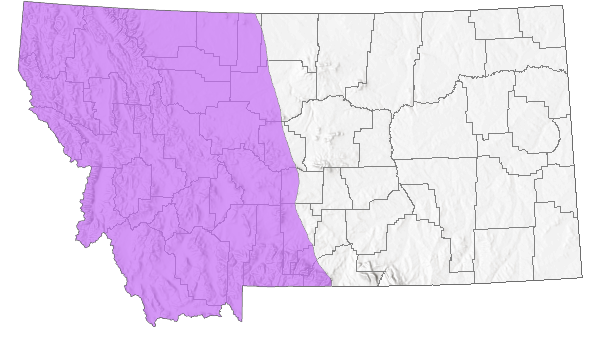
 Native
Native
Range Comments
Circumpolar, south in w. North America to AZ and NM. Sparse.
Observations in Montana Natural Heritage Program Database
Number of Observations: 16
(Click on the following maps and charts to see full sized version)
Map Help and Descriptions
Relative Density
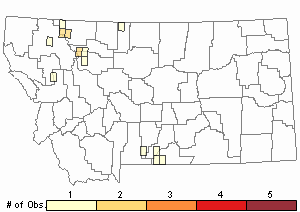
Recency
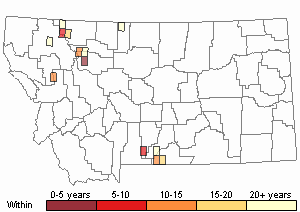
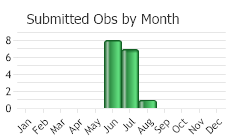
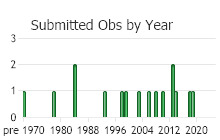
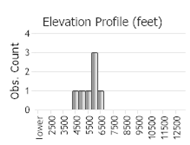 (Observations spanning multiple months or years are excluded from time charts)
(Observations spanning multiple months or years are excluded from time charts)
Habitat
Moist meadows and open woodlands in the montane to alpine zones.
National Vegetation Classification System Groups Associated with this Species
Alpine
Alpine - Vegetated
Grassland
Lowland - Prairie Grassland
Montane - Subalpine Grassland
Wetland and Riparian
Alpine Riparian and Wetland
Riparian Shrubland
Wet Meadow and Marsh
Ecology
POLLINATORS The following animal species have been reported as pollinators of this plant species or its genus where their geographic ranges overlap:
Bombus auricomus,
Bombus bifarius,
Bombus nevadensis, and
Bombus bimaculatus (Macior 1968, Thorp et al. 1983).
Stewardship Responsibility
Threats or Limiting Factors
STATE THREAT SCORE REASON
Reported threats to Montana's population of Northern Buttercup include livestock, oil and gas drilling and invasive non-native species (MTNHP Threat Assessment 2021).
References
- Literature Cited AboveLegend:
 View Online Publication
View Online Publication Macior, L.M. 1968. Bombus (Hymenoptera, Apidae) queen foraging in relation to vernal pollination in Wisconsin. Ecology 49:20-25.
Macior, L.M. 1968. Bombus (Hymenoptera, Apidae) queen foraging in relation to vernal pollination in Wisconsin. Ecology 49:20-25. MTNHP Threat Assessment. 2021. State Threat Score Assignment and Assessment of Reported Threats from 2006 to 2021 for State-listed Vascular Plants. Botany Program, Montana Natural Heritage Program, Helena, Montana.
MTNHP Threat Assessment. 2021. State Threat Score Assignment and Assessment of Reported Threats from 2006 to 2021 for State-listed Vascular Plants. Botany Program, Montana Natural Heritage Program, Helena, Montana. Thorp, R.W., D.S. Horning, and L.L. Dunning. 1983. Bumble bees and cuckoo bumble bees of California (Hymenoptera: Apidae). Bulletin of the California Insect Survey 23:1-79.
Thorp, R.W., D.S. Horning, and L.L. Dunning. 1983. Bumble bees and cuckoo bumble bees of California (Hymenoptera: Apidae). Bulletin of the California Insect Survey 23:1-79.
- Additional ReferencesLegend:
 View Online Publication
View Online Publication
Do you know of a citation we're missing? Fertig, W. and M. Bynum. 1994. Biological report on the proposed Twin Lakes Research Natural Area. Unpublished report to the Shoshone National Forest. Wyoming Natural Diversity Database, Laramie, Wyoming. 33 pp. plus appendices.
Fertig, W. and M. Bynum. 1994. Biological report on the proposed Twin Lakes Research Natural Area. Unpublished report to the Shoshone National Forest. Wyoming Natural Diversity Database, Laramie, Wyoming. 33 pp. plus appendices. Heidel, B.L. 1994. Sensitive plant survey in the Sweetgrass Hills, Liberty and Toole Counties, Montana. Unpublished report for the Great Falls Resource Area, Lewistown District, Bureau of Land Management. Montana Natural Heritage Program, Helena, MT.
Heidel, B.L. 1994. Sensitive plant survey in the Sweetgrass Hills, Liberty and Toole Counties, Montana. Unpublished report for the Great Falls Resource Area, Lewistown District, Bureau of Land Management. Montana Natural Heritage Program, Helena, MT. King, C. R. 1953. The Ranunculaceae of Montana. M.S. Thesis, Bozeman, MT: Montana State College. 82 p.
King, C. R. 1953. The Ranunculaceae of Montana. M.S. Thesis, Bozeman, MT: Montana State College. 82 p. Lesica, P., M.T. Lavin, and P.F. Stickney. 2012. Manual of Montana Vascular Plants. Fort Worth, TX: BRIT Press. viii + 771 p.
Lesica, P., M.T. Lavin, and P.F. Stickney. 2012. Manual of Montana Vascular Plants. Fort Worth, TX: BRIT Press. viii + 771 p. Lesica, P., M.T. Lavin, and P.F. Stickney. 2022. Manual of Montana Vascular Plants, Second Edition. Fort Worth, TX: BRIT Press. viii + 779 p.
Lesica, P., M.T. Lavin, and P.F. Stickney. 2022. Manual of Montana Vascular Plants, Second Edition. Fort Worth, TX: BRIT Press. viii + 779 p.
- Web Search Engines for Articles on "Northern Buttercup"





